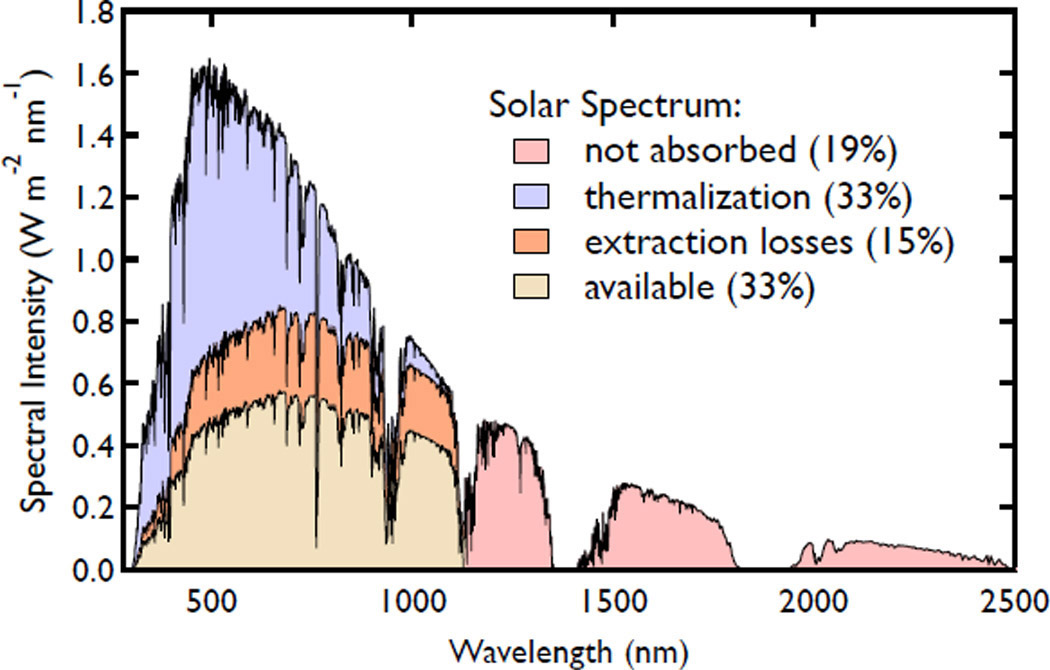Multiple exciton generation in a quantum dot solar cell
Developing ‘third generation’ solar cells that are both highly efficient and inexpensive to manufacture remains an important challenge for their large-scale deployment. Traditional solar cells are limited in their conversion efficiency because they can harvest only a fixed amount of energy per photon, regardless of the photon's total energy. For the majority of the solar spectrum, which contains photon energies ranging from 0.5eV to 4.0eV, this means a significant energy loss. Reducing these losses in an inexpensive, scalable manner has become a significant research priority.
The bandgap of the semiconductor material determines what part of the solar spectrum can be converted by the solar cell: photons with energy less than the bandgap are not absorbed, and photon energy in excess of the bandgap is lost as heat (also called thermalization). This ‘bandgap problem’ leads to a tradeoff, when choosing the bandgap, between absorbing as much light as possible and extracting charge-carriers with as much electrical potential as possible. Also, there are unavoidable extraction losses related to the balance between collecting carriers at a high electrical potential and collecting those carriers before they recombine (see Figure 1 for how all these losses add up for silicon solar cells).

Researchers have attempted to address the ‘bandgap problem’ in many ways, most effectively by layering multiple absorber layers to form so-called multijunction solar cells. However, the material and engineering challenges presented by these high-efficiency cells lead to costs in excess of $10,000/ft2. Photovoltaics that combine high efficiency and low cost are still being sought.1 Our approach is to use ‘multiple exciton generation’ (MEG, also termed carrier multiplication), whereby excited carriers can give some of their energy to promote another electron across the bandgap rather than thermalizing. This allows us to harvest more of the photon's energy. It has been suggested that MEG is more efficient in semiconductor nanocrystals than in bulk semiconductors. These nanocrystalline particles of diameter 1–20nm are also termed quantum dots (QDs). Colloidal quantum dots are solution-processable, meaning that they could easily be scaled up for inexpensive manufacture. The properties of these QDs are very different from those of their bulk counterparts. QDs have a bandgap that is tunable by changing their particle size rather than composition. MEG has been characterized in a number of spectroscopic studies of colloidal solutions of QDs, and some studies have suggested that MEG-like processes occur in films of electronically-coupled QDs, but until now no solar cell had been shown to generate more electrons than the number of incident solar photons.2–5
In a solar cell, MEG is measured by determining the cell's external and internal quantum efficiencies at zero applied bias. These are the ratios of electrons generated either per photon incident on (external) or absorbed by (internal) the solar cell, respectively. Measuring an external quantum efficiency greater than 100% would indisputably indicate that MEG was occurring. Previous measurements of MEG in colloidal solutions were challenged because either the measurement was performed at high photon fluences, or the quantum dots were not electronically coupled to each other. If MEG had an intensity dependence, it could be unable to improve solar cell efficiency at typical solar fluences. Similarly, it was unclear if electronic coupling of the QDs would remove the quantization effects that produce the enhanced Coulomb coupling that drives MEG in QDs. In our work, which yielded a peak external quantum efficiency as high as 114% and a peak internal quantum efficiency of 130% (see Figure 2), we conclusively showed not only that multiple excitons are generated in QDs, but also that they can be collected with reasonable efficiency.6

The champion solar cells developed in this work were made possible by a multiple-treatment process to deposit lead selenide (PbSe) QDs. After depositing a sol-gel derived n-type zinc oxide film on the transparent conducting substrate (indium tin oxide on glass), we used layer-by-layer dip-coating to build up p-type PbSe QDs 50–250nm thick. We used 1,2-ethanedithiol (EDT) to remove the insulating surface ligands (thereby coupling the QDs), a treatment used for many years in QD solar cells.7 Following this, we deposited another 30nm layer of QDs using hydrazine as the coupling treatment. This secondary treatment appears to improve the quality of both the EDT-layer and the bottom layer of the solar cell (in previous work, the backside interface has been plagued by an opposing Schottky junction created by the thermally evaporated gold bottom layer.) The heterojunction of this solar cell is on the incident sunlight side of the active layer, and so the UV and blue photons that benefit from MEG are absorbed very close to where the built-in field is strongest and are more easily collected before recombination.8
Third-generation solar cells necessitate improvement to the theoretical limits of solar energy conversion efficiencies. The impact of MEG on the power conversion efficiency of QD solar cells is still small, but this work opens the door to a new field of device physics: the development of solar cells that generate multiple carriers per visible photon. This approach to the bandgap problem will need improved MEG rates, and already shows promise in carbon nanotubes and PbSe nanorods.9, 10 We are currently working to incorporate nanotubes and nanorods into our solar cell architecture, as well as striving to understand the mechanism of the secondary treatment that very much improves device performance.
This work was supported by the Center for Advanced Solar Photophysics, an Energy Frontier Research Center funded by the US Department of Energy (DOE), Office of Science, Office of Basic Energy Sciences. DOE funding was provided to the National Renewable Energy Laboratory through contract DE-AC36-08GO28308.
Octavi E. Semonin is a PhD candidate in the Department of Physics at the University of Colorado, Boulder. He plans to graduate this summer, and is currently seeking a post-doctoral research position in advanced solar energy conversion strategies.
National Renewable Energy Laboratory



